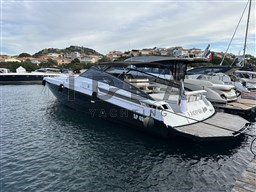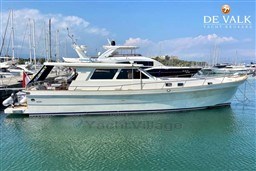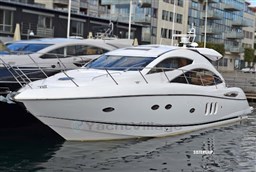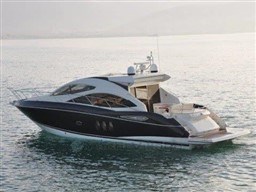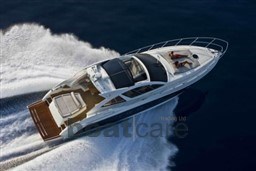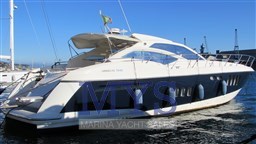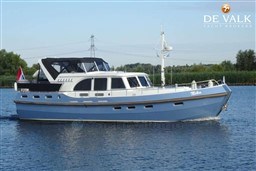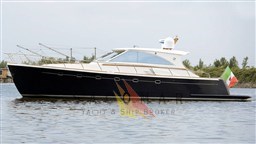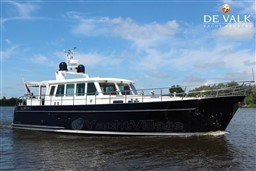Cantieri Di Baia B50 (2011) For sale
Description
The Baia B50′ represents an icon of 1980s nautical design, symbolizing excellence and innovation from the renowned Naples-based shipyard. This model, one of the largest and most celebrated successes of its era, distinguished itself not only through numerous victories in international competitions but also by marking a turning point in the production philosophy of Baia Yachts. The hull, designed by the renowned engineer Don Aronow, ensured superior performance and high onboard comfort, also capturing the U.S. market thanks to its exceptional versatility and reliability.
The new B50' maintains the luxury and comfort features of its predecessor, enhanced with innovative elements and high-quality details that further elevate its excellence. The owner's cabin, centrally located amidships, is illuminated by large lateral windows, creating a bright and refined environment, and includes a dedicated bathroom with a separate shower enclosure. The forward VIP cabin features dual access to the bathroom, allowing it to be reached both from the cabin itself and from the main salon, thus ensuring practicality and privacy from the main living area.
The layout arrangement, with a bar separating the kitchen from the lounge, combined with expansive windows and skylights on the deck, creates a bright and welcoming ambiance, enhanced by high-quality finishes and meticulously crafted details.
Compared to the previous model, the length has been increased from 4.20 meters to 4.60 meters, with a particular focus on understated, minimalist luxury. The deep V hull, with smooth contours and a sharp bow, has been designed to optimize speed and handling while maintaining the elegant lines characteristic of the classic 1980s open models. It incorporates advanced technological solutions typical of modern fast commuter vessels. Careful engineering has also significantly reduced overall weight, promoting high performance and low fuel consumption, aligned with environmental sustainability.
The engine, composed of latest-generation turbocharged diesel units with common rail technology, is lightweight, compact, and electronically controlled, further enhancing the vessel's performance and efficiency. The hull construction employs vacuum-infused lamination techniques with epoxy resins, ensuring lightweight strength and complete resistance to osmosis. This technology also isolates operators from harmful styrene emissions, elevating safety and sustainability standards.
The new B50' maintains the luxury and comfort features of its predecessor, enhanced with innovative elements and high-quality details that further elevate its excellence. The owner's cabin, centrally located amidships, is illuminated by large lateral windows, creating a bright and refined environment, and includes a dedicated bathroom with a separate shower enclosure. The forward VIP cabin features dual access to the bathroom, allowing it to be reached both from the cabin itself and from the main salon, thus ensuring practicality and privacy from the main living area.
The layout arrangement, with a bar separating the kitchen from the lounge, combined with expansive windows and skylights on the deck, creates a bright and welcoming ambiance, enhanced by high-quality finishes and meticulously crafted details.
Compared to the previous model, the length has been increased from 4.20 meters to 4.60 meters, with a particular focus on understated, minimalist luxury. The deep V hull, with smooth contours and a sharp bow, has been designed to optimize speed and handling while maintaining the elegant lines characteristic of the classic 1980s open models. It incorporates advanced technological solutions typical of modern fast commuter vessels. Careful engineering has also significantly reduced overall weight, promoting high performance and low fuel consumption, aligned with environmental sustainability.
The engine, composed of latest-generation turbocharged diesel units with common rail technology, is lightweight, compact, and electronically controlled, further enhancing the vessel's performance and efficiency. The hull construction employs vacuum-infused lamination techniques with epoxy resins, ensuring lightweight strength and complete resistance to osmosis. This technology also isolates operators from harmful styrene emissions, elevating safety and sustainability standards.
Cantieri Di Baia B50 (2011) - 420,000 EUR
Cantieri Di Baia B50 (2011) For sale
Main data
Shipyard
Cantieri di Baia
Model
B50
Year built
2011
Length
17.1
m
Boat Type
Open
Code
844682
Last updated
7/21/2025
Sale pending
Price
Price
420,000 EUR
VAT
VAT Paid
Engines
Power
2 x 800 Hp
Model
MAN R6
Transmission
Surface prop
Engine hours
983
Located
Visible country
Italy
Technical data
First registration
2011
Width
4.65
m
Draft
0.9
m
Displacement
21,000
kg
Max people transportable
12
Maximum speed
43
Kn
Cruise speed
36
Kn
Fuel tank
2,000
l
Water tank
500
l
Flag
Italy
Hull Shape
Deep V
Propeller type
Arneson Drive Asd 12 b1L
Electrical installation
24V, 220V
Generators
Power
1 x 9 Kw
Accessories
Navigation equipment
Chartplotter (Garmin GPSMap 5012)
Compass
Depth Sounder (Humminbird)
Electronic engine control
Odometer
Rudder angle indicator
VHF Radio
Staging and technical
Anchor
Batteries
Battery charger
Bilge Alarm
Bow Thruster
cockpit table
Courtesy Lights
Deck Shower
Electric Windlass
Engine Alarm
Gangway (Hyraulic telescopic)
Horn
Platform
Shorepower connector
Teak Cockpit
Tender Garage
Washbasin in the cockpit
Water pressure pump
Domestic Facilities onboard
220V Outlets
Air Conditioning
3 x Electric Toilet
Heater
Inverter
Inverter Air Conditioning
Warm Water System
Waste Water Plant
Entertainment
Hi-Fi
Radio AM/FM
Speakers (Fusion)
TV
TV Ready
Kitchen and appliances
Ceramic hot plate (Bosh Induction 4 burners)
Deck Refrigerator
Galley
Refrigerator
Upholstery
Bimini
Bow Cushions
Cockpit Cushions
Cushions
Do you want to know more about this boat?
Habitability
Number of cabins
2
Number of bathrooms
2
Cabins berths
4
Crew berths
1
Total berths
4
Composition
2 x Double King Size
1° Double King Size
Amidship
2° Double King Size
Forward
Cabin crew
Crew Toilet
2 x Toilet with shower no bidet
1° Toilet with shower no bidet
dual access allowing it to be reached both from the cabin itself and from the main salon
Materials
No data available
Do you want to know more about this boat?
© 2025 YachtVillage - Design by Digibusiness Srl - P.IVA IT02184210348 - Powered by Navis.net




